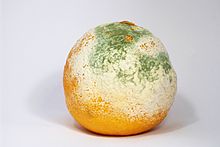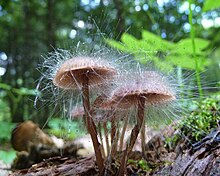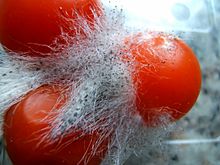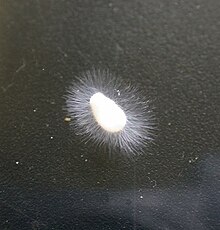Mold
This article needs additional citations for verification. (November 2008) |





Molds (or moulds; see spelling differences) are fungi that grow in the form of multicellular filaments called hyphae.[1] A connected network of these tubular branching hyphae has multiple, genetically identical nuclei and is considered a single organism, referred to as a colony. In contrast, fungi that grow as single cells are called yeasts.
Molds are considered to be microbes and do not form a specific taxonomic or phylogenetic grouping, but can be found in the divisions Zygomycota, Deuteromycota and Ascomycota. Some molds cause disease or food spoilage; others play an important role in biodegradation or in the production of various foods, beverages, antibiotics and enzymes.
Biology
There are thousands of known species of molds which include opportunistic pathogens, saprotrophs, aquatic species and thermophiles.[2] Like all fungi, molds derive energy not through photosynthesis but from the organic matter in which they live. Typically, molds secrete hydrolytic enzymes, mainly from the hyphal tips. These enzymes degrade complex biopolymers such as starch, cellulose and lignin into simpler substances which can be absorbed by the hyphae. In this way molds play a major role in causing decomposition of organic material, enabling the recycling of nutrients throughout ecosystems. Many molds also secrete mycotoxins which, together with hydrolytic enzymes, inhibit the growth of competing microorganisms.
Molds reproduce through small spores,[2] which may contain a single nucleus or be multinucleate. Mold spores can be asexual (the products of mitosis) or sexual (the products of meiosis); many species can produce both types. Mold spores may remain airborne indefinitely, may cling to clothing or fur or may be able to survive extremes of temperature and pressure.
Although molds grow on dead organic matter everywhere in nature, their presence is visible to the unaided eye only when mold colonies grow. A mold colony does not consist of discrete organisms but of an interconnected network of hyphae called a mycelium. Nutrients and in some cases organelles may be transported throughout the mycelium. In artificial environments such as buildings, humidity and temperature are often stable enough to foster the growth of mold colonies, commonly seen as a downy or furry coating growing on food or other surfaces.
Few molds can begin growing at 4 °C (39 °F), the temperature within a typical refrigerator, or less. When conditions do not enable growth to take place, molds may remain alive in a dormant state depending on the species, within a large range of temperatures before they die. The many different mold species vary enormously in their tolerance to temperature and humidity extremes. Certain molds can survive harsh conditions such as the snow-covered soils of Antarctica, refrigeration, highly acidic solvents, anti-bacterial soap and even petroleum products such as jet fuel.
Xerophilic molds use the humidity in the air as their only water source; other molds need more moisture.
Common molds
Food production
The Kōji (麹) molds are a group of Aspergillus species, notably Aspergillus oryzae, and secondarily A. sojae, that have been cultured in eastern Asia for many centuries. They are used to ferment a soybean and wheat mixture to make soybean paste and soy sauce. Koji molds break down the starch in rice, barley, sweet potatoes, etc., a process called saccharification, in the production of sake, shōchū and other distilled spirits. Koji molds are also used in the preparation of Katsuobushi.
Red rice yeast is a product of the mold Monascus purpureus grown on rice, and is common in Asian diets. The yeast contains several compounds collectively known as monacolins, which are known to inhibit cholesterol synthesis.[3] According to a study published in the journal Mayo Clinic Proceedings by Dr. David Becker, red rice yeast used as a dietary supplement, combined with fish oil and healthy lifestyle changes, may help reduce "bad" cholesterol as effectively as certain commercial statin drugs.[4]
Some sausages, such as salami, use starter cultures[5] in their production, to improve flavour and reduce spoilage during curing.
Other molds that have been used in food production include:
- Fusarium venenatum – quorn
- Geotrichum candidum – cheese
- Neurospora sitophila – oncom
- Penicillium spp. – cheese
- Rhizomucor miehei – rennet for making vegetarian and other cheese
- Rhizopus oligosporus – tempeh
- Ustilago maydis – filling in tortilla-based foods
Drug creation
Alexander Fleming's famous discovery of the antibiotic penicillin involved the mold Penicillium chrysogenum.
Several cholesterol-lowering drugs (such as Lovastatin, from Aspergillus terreus) are derived from molds.
Howard Florey made Penicillin into a miracle drug which saved over 6 million lives.
The immunosuppressant drug cyclosporine, used to suppress the rejection of transplanted organs, is derived from the mold Tolypocladium inflatum.
Health effects
Molds are ubiquitous in nature, and mold spores are a common component of household and workplace dust. However, when mold spores are present in large quantities, they can present a health hazard to humans, potentially causing allergic reactions and respiratory problems.
Some molds also produce mycotoxins that can pose serious health risks to humans and animals. Studies claim that exposure to high levels of mycotoxins can lead to neurological problems and in some cases death. Prolonged exposure, e.g. daily workplace exposure, may be particularly harmful. Research on the health effects of mold has not been conclusive. The term "toxic mold" refers to molds that produce mycotoxins, such as Stachybotrys chartarum, and not to all molds in general.[6]
Mold in the home can usually be found in damp, dark or steam filled areas e.g. bathroom or kitchen, cluttered storage areas, recently flooded areas, basement areas, plumbing spaces, areas with poor ventilation and outdoors in humid environments. Symptoms caused by mold allergy are watery, itchy eyes, a chronic cough, headaches or migraines, difficulty breathing, rashes, tiredness, sinus problems, nasal blockage and frequent sneezing.
Growth in buildings and homes
Mold growth in buildings can lead to a variety of health problems. Various practices can be followed to mitigate mold issues in buildings, the most important of which is to reduce moisture levels that can facilitate mold growth.[6] Removal of affected materials after the source of moisture has been reduced and/or eliminated may be necessary for remediation.
See also
References
- ^ Madigan M; Martinko J (editors). (2005). Brock Biology of Microorganisms (11th ed.). Prentice Hall. ISBN 0-13-144329-1. OCLC 57001814.
{{cite book}}:|author=has generic name (help)CS1 maint: multiple names: authors list (link) - ^ a b Ryan KJ; Ray CG (editors) (2004). Sherris Medical Microbiology (4th ed.). McGraw Hill. pp. 633–8. ISBN 0-8385-8529-9.
{{cite book}}:|author=has generic name (help)CS1 maint: multiple names: authors list (link) - ^ "Red yeast rice (Monascus purpureus)". Mayo Clinic. 2009-09-01. Retrieved 2010-02-01.
- ^ "Study: Red Rice Yeast Helps Cut Bad Cholesterol". National Public Radio. 2008-07-01. Retrieved 2010-02-01.
- ^ L. H. Stahnke, L. O. Sunesen (2003-11). "Mould starter cultures for dry sausages—selection, application and effects". Meat Science. 65 (3): 935–948. doi:10.1016/S0309-1740(02)00281-4. Retrieved 2008-06-06.
{{cite journal}}: Check date values in:|date=(help) - ^ a b Indoor Environmental Quality: Dampness and Mold in Buildings. National Institute for Occupational Safety and Health. August 1, 2008.
